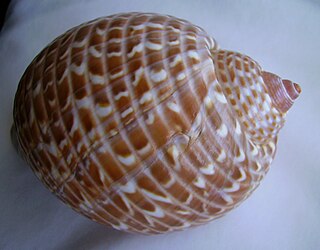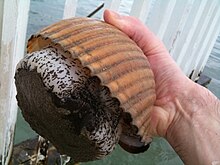
The Tonnidae are a family of medium-sized to very large sea snails, known as the tun shells. These are marine gastropod molluscs in the clade Littorinimorpha. The name tun refers to the snails' shell shape, which resembles wine casks known as "tuns". While thin, the shells are also strong and lack opercula. They are found in all tropical seas, where they inhabit sandy areas. During the day, they bury themselves in the substrate, emerging at night to feed on echinoderms, crustaceans, and bivalves. Some larger species also capture fish, using their expandable probosces to swallow them whole. Females lay rows of eggs that become free-swimming larvae for several months before settling to the bottom.

Buccinum is a genus of medium-sized sea snails, marine gastropod molluscs in the family Buccinidae, the true whelks.

Tonna cumingi, common name Cuming's tun, is a species of very large sea snail, a tun snail, a marine gastropod mollusc in the family Tonnidae, the tuns.

Ranella olearium, common name the wandering triton or the little frog triton or olive trumpet, is a species of large sea snail, a marine gastropod mollusc in the family Ranellidae, the tritons.

Tonna is a genus of large sea snails, marine gastropod molluscs in the family Tonnidae, the tun or cask shells.

Tonna dolium, common name the spotted tun, is a species of large sea snail or tun snail, a marine gastropod mollusc in the family Tonnidae, the tun shells.

Tonna perdix, common name the partridge tun, is a species of very large sea snail, a marine gastropod mollusc in the family Tonnidae, the tun shells.

Cymatium is a genus of small to large predatory sea snails, marine gastropod mollusks in the family Cymatiidae.

Turris babylonia, common name: the Babylon turrid or tower turrid, is a species of sea snail, a marine gastropod mollusk in the family Turridae, the turrids.

Nassarius arcularia, the casket nassa or the little box dog whelk, is a species of sea snail, a marine gastropod mollusk in the family Nassariidae, the Nassa mud snails or dog whelks. It is found in tropical and subtropical coastal waters across the world, inhabiting muddy areas close to the shoreline.

Charonia lampas is a species of predatory sea snail, a marine gastropod mollusk in the family Charoniidae.

Malea pomum, common name the Pacific grinning tun, is a species of large sea snail, a marine gastropod mollusk in the family Tonnidae, the tun shells.

Tonna canaliculata is a species of large sea snail, a marine gastropod mollusk in the family Tonnidae, the tun shells.

Tonna deshayesii is a species of large sea snail, a marine gastropod mollusk in the family Tonnidae, the tun shells.

Tonna pennata is a large species of sea snail, a marine gastropod mollusc in the family Tonnidae, the tun shells. Commonly known as the Atlantic partridge tun, the species is a predator of animals much larger than itself, particularly sea cucumbers.

Tonna sulcosa, common name banded tun, is a species of large sea snail, a marine gastropod mollusk in the family Tonnidae, the tun shells.

Thylacodes arenarius is a species of sea snail, a marine gastropod mollusk in the family Vermetidae, the worm snails or worm shells.

Tonna chinensis, common name : the China tun, is a species of large sea snail, a marine gastropod mollusk in the family Tonnidae, the tun shells.

Tritia neritea is a species of sea snail, a marine gastropod mollusk in the family Nassariidae, the Nassa mud snails or dog whelks.

Tonna variegata, commonly known as the variegated tun, is a species of marine gastropod mollusc in the family Tonnidae.























